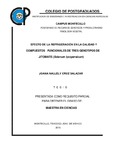| dc.description.abstract | El jitomate (Solanum lycopersicum) es popular mundialmente, por el color atractivo, valor nutricional y versatilidad de uso; la calidad de los frutos depende de atributos externos (tamaño, forma, color, apariencia) e internos (aroma, sabor, textura). La selección de nuevas variedades en años recientes se ha basado en la calidad sensorial y compuestos funcionales. El objetivo de este trabajo es efectuar un estudio comparativo de la calidad postcosecha y preferencia de consumidores potenciales de frutos frescos de tres genotipos de jitomate, Híbrido Comercial (HC), Línea Experimental (LE) y Colecta Nativa (CN), en frutos recién cosechados y almacenados nueve días a 23 ºC.; así como analizar el contenido de antioxidantes (licopeno, β-caroteno y vitamina C), capacidad antioxidante y daño a lípidos en frutos recién cosechados y efecto del almacenamiento a 10 ºC y 23 ºC. Los resultados indican que los frutos del HC fueron de mayor preferencia y considerados más frescos por los consumidores. Se asocian con los descriptores herbal, cítrico y dulce, presentaron menor AT, mayor relación SST/AT y firmeza y menor PP. Los frutos de LE no agradaron ni desagradaron, tuvieron menor frescura, presentaron valores intermedios de AT y SST/AT, firmeza elevada y mayor PP que los frutos del HC. Los frutos de CN, a una parte de los consumidores les agradaron y a otra les desagradaron, probablemente por tener aroma y sabor menos familiar; fueron los menos frescos, con mayor AT, menor SST/AT, PP similar a la de LE y menor firmeza, la cual afecta su potencial de comercialización como fruto fresco. Los niveles de licopeno en los frutos recién cosechados, no presentaron diferencias significativas entre genotipos, mientras que los niveles de β-caroteno y vitamina C fueron más altos en el HC. Durante el almacenamiento a 23 ºC los niveles de licopeno y vitamina C son mayores, en tanto que los niveles de β-caroteno no presentaron diferencias significativas respecto a los frutos recién cosechados. En los frutos almacenados a 10 ºC, los niveles de licopeno y β-caroteno no presentaron diferencias significativas respecto a los frutos recién cosechados, con excepción de LE en que hubo aumento; por otra parte, los niveles de vitamina C aumentaron en CN y LE y disminuyeron en HC. Respecto a la capacidad antioxidante, en los frutos recién cosechados y almacenados por 9 días en refrigeración a 10 ºC, no se observaron diferencias significativas entre los tres genotipos, en los frutos almacenados por 9 días a 23 ºC se observó un aumento en CN. En relación al daño a lípidos medido por lipoperoxidación, no se observaron diferencias entre genotipos en frutos recién cosechados, ni por efecto del almacenamiento, tanto a 10 ºC como a 23 ºC. Se concluye que los frutos con mejores características de calidad, niveles de compuestos funcionales, frescura y preferencia de consumidores son los del HC. _______________ EFFECT OF COOLING ON THE QUALITY AND FUNCTIONAL COMPOUNDS OF THREE TOMATO GENOTYPES (Solanum lycopersicum). ABSTRACT: The tomato (Solanum lycopersicum) is a world-wide popular fruit due to its attractive color, nutritional value, and versatility of use; fruit quality is determined by both external (size, form, color, appearance) and internal (aroma, flavor, texture) attributes. In recent years, sensory qualities and functional compounds have become increasingly relevant in the selection of new varieties. The objective of the present work was to perform a comparative study on the postharvest quality and consumer preference of three tomato fruit genotypes: commercial hybrid (CH), experimental line (EL), and native selection (NS), as evaluated in both freshly harvested fruit and in tomatoes stored for 9 days at 23 °C, as well as an analysis of the antioxidant content (lycopene, β-carotene, and vitamin C), capacity, and extent of lipid damage, in freshly harvested fruits together with the effects of storage at 10 °C and 23 °C in these parameters. Results showed that CH fruits were the most preferred and considered to be fresher by consumers. They were associated to herbal, citric, and sweet descriptors, presented a lower TA and WL, and had a higher TSS/TA ratio. EL fruits on the other hand, were neither liked nor disliked by consumers, were perceived as being less fresh, had intermediate values of TA and TSS/TA, a relatively high firmness, and a higher WL than CH fruits. Lastly, while some consumers liked NS fruits, others disliked them, – probably due to a less familiar aroma and flavor. They were perceived as being the least fresh, presented a higher TA and a lower TSS/TA ratio, had a similar WL to EL fruits, and had lower firmness values – the latter affecting its potential to be commercialized as fresh fruit. When comparing the levels of lycopene in freshly harvested fruits, no significant differences were observed among the three genotypes, whereas the levels of β-carotene and vitamin C were higher in CH fruits. During storage at 23 °C the levels of lycopene and vitamin C increased, while the levels of β-carotene showed no significant differences from those of freshly harvested fruits. Likewise, there were no significant differences in the lycopene and β-carotene levels of fruits stored at 10 °C from those present in freshly harvested produce with the exception of EL fruits, which did present an increase in both of these compounds. Furthermore, the levels of vitamin C increased in both NS and EL genotypes, while they decreased in CH fruits. No differences among genotypes were observed in the antioxidant capacity of fresh fruits and fruits stored for 9 days at 10 °C, whereas an increase was observed in NS fruits stored for 9 days at 23 °C. Likewise, no differences existed among the genotypes in terms of lipid damage as measured by the level of lipoperoxidation of membranes, either in freshly harvested fruits or in those stored at 10 °C or 23 °C. It is therefore concluded that CH fruits have the best quality characteristics, levels of functional compounds, freshness, and consumer preference, compared with the other two genotypes evaluated. | es_MX |


